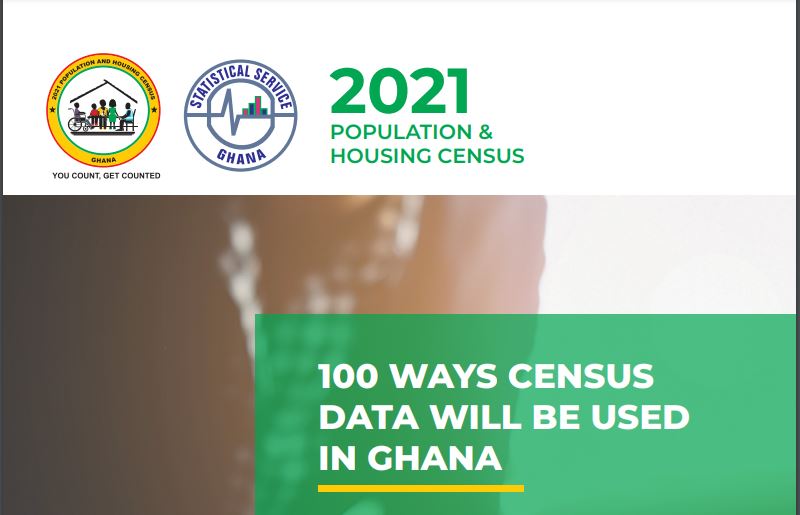Table of Contents
Population and Housing Census (PHC) in Ghana, 2021
The conduct of the Ghana 2021 Population and Housing Census (PHC) will provide updated demographic, social, and economic data to support national development activities and for tracking the implementation of global and continental development goals including the Sustainable Development Goals, International Conference on Population and Development goals, and Africa’s Agenda 2063.
The Ghana Statistical Service has highlighted the benefits of the data that will be collected on individuals, households, and structures, during the listing and enumeration exercise. Also, the resourcefulness of geo-spatial data for all the over 131,000 localities in Ghana that were collected during the Census Mapping exercise and will be updated during the fieldwork for the main census have been cataloged.
The census will produce data on who we are, how many are we, as well as where and how we live. The data are expected to be used by the government, private sector, businesses, civil society organizations, development partners, special interest groups, academics, media, households, and other stakeholders to conduct research and generate information for general use and to inform specific policies and their implementation.
Check Here: 2021 PHC: Selection of Census Field Officers
Data from the 2021 PHC will be used, among others, in the following areas:
POLICY AND DECISION MAKING
1. Inform the distribution of local government funds.
2. Plan government budgets at all levels.
3. Inform decisions on the public infrastructure needed in the localities.
4. Provide guidance on the creation of districts based on population size.
5. Provide guidance on the creation of electoral areas based on population size.
6. Plan future government services based on population needs.
7. Inform environmental protection policies based on the use of cooking fuels, availability of potable water.
8. Plan the location of public services based on population distribution.
9. Create informative maps for government and businesses to make decisions.
10. Provide data to help plan for the dependent populations (including children, elderly, and persons with difficulty in performing activities).
11. Provide sampling frames for future surveys such as the Ghana Living Standards Survey that will generate further data to solve the country’s development challenges.
DEVELOPMENT
12. Monitor progress towards development targets including the Coordinated Programme of Economic and Social Development Policies (2017 to 2024), Africa’s Agenda 2063, and the Sustainable Development Goals (SDGs).
13. Monitor trends in the economic well-being of the population.
14. Create maps to speed emergency services to households in need of assistance.
15. Use information on economic activities for the development of rural areas.
16. Obtain data on the proportion of the urban population living in slums, informal settlements, or poor housing conditions.
17. Provide data on the prevalence of difficulty in performing activities to aid the government to formulate inclusive policies.
18. Know the building density for urban planning.
19. Identify households and individuals in poverty for the programming of assistance.
Read also all you need to know about 2021 Population and Housing Census – Ghana Statistical Service
HOUSING
20. Identify current housing needs of the population.
21. Obtain information on the proportion of structures with Ghana Digital Post Addresses.
22. Guide planning based on the data on uncompleted structures.
23. Provide data on residential and non-residential structures to inform policy where there is a deficit in either category.
24. Provide data on the use of structures listed to ascertain the stock of habitable structures.
25. Provide data on room occupancy to inform policy and fill housing deficits.
26. Provide data on main construction materials (walls, roofing, and floors) for dwelling units of the population to inform the government on the quality of structures.
27. Obtain data on housing stock.
28. Determine housing security using the information on tenure and holding arrangements.
29. Determine areas eligible for housing assistance and rehabilitation.
30. Forecast future housing needs.
31. Obtain information on the number of households sharing dwelling units with other households
Final Ghana Statistical Service Population and Housing Census Brochure
GEOGRAPHY
32. Plan urban land use
33. Establish boundaries of localities, constituencies, districts, and regions.
34. Identify localities and districts with boundary issues to seek the appropriate resolutions.
35. Identify new localities.
36. Integrate population data with maps for geo-spatial analyses.
37. Know the ease of accessibility (geometry, perimeter, compactness) within districts.
38. Identify gaps and overlaps of the already existing district and locality boundaries.
39. Identify deserted or collapsed localities.
40. Know the population density by locality, district, and region for urban planning.
41. Estimate the number of people displaced by natural disasters.
WATER & SANITATION
42. Improve sanitation using the information on solid waste disposal, wastewater disposal, and toilet facilities.
43. Obtain data on the types of bathing facilities used by households.
44. Obtain data on the meantime taken to access potable water.
45. Obtain data on households that use various forms of toilet facilities (private, public, communal) in order to bridge the deficit gap
46. Obtain data on localities that practice open defecation.
47. Obtain data on households that use standard waste bins by urban/rural to ensure that goal six of the SDG on sanitation is achieved.
48. Obtain data on households that practice open burning of waste to inform policy.
49. Obtain information on the proportion of households that dispose of their wastewater by throwing it out onto the open to inform Government decision-making on developing the drainage systems of the communities.
50. Use data to map out the access to improved water and sanitation facilities.
UTILITIES AND ENERGY
51. Obtain information on the primary and secondary lighting sources used by households.
52. Obtain information on households using electricity (mains, generator, solar, etc.) to ensure fair distribution of affordable and clean energy as required by SDG 7.
53. Obtain information on the proportion of households sharing cooking facilities with other households.
BUSINESSES
54. Use the industrial distribution of the labor force for planning.
55. Obtain data on businesses and their locations.
56. Provide geospatial information to inform the location of factory sites and distribution.
57. Use data to identify the potential location of the business.
58. Undertake market research to understand consumer needs.
EDUCATION
59. Identify localities where new schools may be needed.
60. Direct services to children and adults with limited literacy.
61. Develop adult education programs from the literacy data obtained.
62. Know the number of educated persons from basic to tertiary level to inform educational policies.
63. Obtain information on the proportion of children (5-14 years) who are not in school.
64. Provide levels of literacy of the population.
DEMOGRAPHIC
65. Provide age-sex dis-aggregated data.
66. Make population and workforce projections.
67. Develop targeted social interventions for vulnerable populations.
68. Identify internal and international migrants, their distribution, and their characteristics.
69. Provide data on migration patterns of the population to formulate migration policies.
70. Provide information on religious affiliations of the population.
71. Provide information on the ethnicity of the population across regions and districts.
72. Provide information on the nationality of persons living in Ghana.
73. Provide data on the sizes of localities and their population.
74. Provide data on factors of natural population change (fertility and mortality).
75. Provide information on marriage patterns of the adult population (current marital status).
76. Provide information on the married population i.e. traditional, ordinance, etc.
ICT
77. Provide data on internet usage by place of residence.
78. Provide data on ownership of smartphones and other ICT devices.
79. Obtain data on the population with access to mobile phones.
80. Obtain data on the usage of ICT to inform decision-making in the telecommunications sector.
HEALTH & WELL-BEING
81. Provide data on the location of hospitals, health centers, Community-based Health plans and Services (CHPS) compounds, and other health facilities.
82. Provide data on maternal mortality.
83. Provide data on child mortality.
84. Provide data that can be used to calculate how long people live on average (life expectancy).
85. Provide data on the proportion and distribution of persons with difficulties performing activities (seeing, hearing, speech, walking, remembering, and concentrating, self-care and speech).
86. Assess the potential for the spread of communicable diseases based on population density and sanitation.
87. Provide information on the general causes of death (illness, or pregnancy-related or accident/violence/homicide/suicide,)
LABOR FORCE
88. Obtain information on the labor force distribution in the various industries.
89. Provide data on employment status to inform labor policies.
90. Obtain information on occupation distribution of the population for policy and planning.
91. Determine the proportion of children 5-14 years engaged in child labor.
92. Provide information on labor supply.
93. Obtain information on occupation distribution of the population for policy and planning.
94. Obtain data on professionals in the economically active population.
95. Provide data on underemployment among the population.
SOCIOECONOMIC
96. Provide data to guide policies to reduce inequality across various sections of society (e.g. within and across districts, among socioeconomic groups).
97. Provide information to design public safety strategies.
98. Analyze changes in the socioeconomic, demographic, and living arrangements. and conditions since the previous census.
99. Measure the living standards of the population using the information on household ownership of assets (vehicles, farm equipment, televisions, refrigerators, etc.).
100. Measure financial inclusion based on usage of mobile phones for mobile money and other financial transactions.
Source: census2021.statsghana.gov.gh





